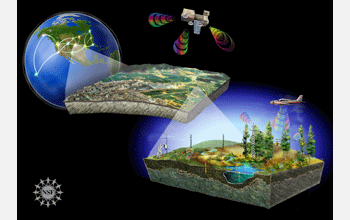Multimedia Gallery
NEON Distributed Sensor Networks
An artist's conception of the National Ecological Observatory Network (NEON) depicting its distributed sensor networks, experiments and aerial and satellite remote sensing capabilities, all linked via cyberinfrastructure into a single, "scalable," integrated research platform for conducting continental-scale ecological research. NEON is one of several National Science Foundation (NSF) Earth-observing systems.
The NEON observatory includes 20 eco-climatic domains that cover the contiguous 48 states, Alaska, Hawaii and Puerto Rico. Each domain represents a distinct region of vegetation, landforms, climate and ecosystem performance. Domain boundaries were determined using a statistical clustering algorithm and data developed by William Hargrove and Forrest Hoffman of Oak Ridge National Laboratory.
The data NEON collects and provides will focus on how land use change, climate change and invasive species affect the structure and function of our ecosystems. Obtaining this kind of data over a long-term period is crucial to improving ecological forecast models. The observatory will enable a virtual network of researchers and environmental managers to collaborate, coordinate research and address ecological challenges at regional, national and continental scales by providing comparable information across sites and regions.
NEON is being planned and built by NEON Inc., a nonprofit corporation. Funding for NEON comes from the National Science Foundation's Emerging Frontiers Division in the Biological Sciences Directorate. To learn more, visit the NEON website. (Date of Image: 2009)
Credit: Nicolle Rager Fuller, National Science Foundation
See other images like this on your iPhone or iPad download NSF Science Zone on the Apple App Store.
Images and other media in the National Science Foundation Multimedia Gallery are available for use in print and electronic material by NSF employees, members of the media, university staff, teachers and the general public. All media in the gallery are intended for personal, educational and nonprofit/non-commercial use only.
Images credited to the National Science Foundation, a federal agency, are in the public domain. The images were created by employees of the United States Government as part of their official duties or prepared by contractors as "works for hire" for NSF. You may freely use NSF-credited images and, at your discretion, credit NSF with a "Courtesy: National Science Foundation" notation.
Additional information about general usage can be found in Conditions.
Also Available:
Download the high-resolution JPG version of the image. (703 KB)
Use your mouse to right-click (Mac users may need to Ctrl-click) the link above and choose the option that will save the file or target to your computer.



